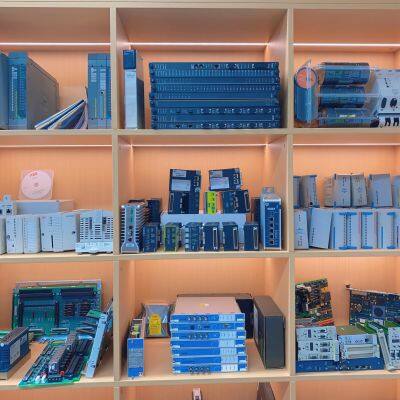Product Description
I. Product Overview
The 1771-OJ module is a digital output module in the Allen-Bradley 1771 series, which undertakes important digital signal output tasks in industrial automation control systems. It can receive digital control commands from the PLC controller and convert them into corresponding switching output signals, thereby accurately controlling the operating status of various external digital load devices, such as contactors, solenoid valves, indicator lights, etc., providing stable and reliable control support for the automated operation of industrial production processes.
The module adopts a standardized compact structure design, which is highly compatible with the 1771 series I/O enclosures and can be easily installed in various industrial control cabinets, greatly saving installation space. The shell is made of high-quality industrial-grade materials, with excellent anti-vibration and anti-impact performance, and can maintain stable operation in environments with continuous vibration such as mechanical processing workshops and automated production lines. At the same time, its shell also has good dust-proof and moisture-proof capabilities, which can adapt to the complex working conditions of dust and humidity in industrial sites, ensuring that the module can perform output control tasks reliably for a long time.

II. Performance Parameters
(1) Electrical Characteristics
Power Requirement: The working power of the 1771-OJ module comes from the backplane of the 1771 I/O enclosure, and usually requires two types of power supplies: +5V DC and +24V DC. Among them, +5V DC is mainly used to power the internal logic circuit of the module, with a typical current consumption within a certain range; +24V DC is used to drive external loads to ensure the stable output of the output signal. This dual power supply mode not only ensures the normal operation of the internal circuit of the module, but also provides sufficient driving force for external loads, and simplifies the power supply design of the system.
Number of Output Points: The module has 16 digital output channels, which can control 16 external digital load devices at the same time, meeting the needs of small and medium-sized industrial control systems for digital control of multiple devices. If more devices need to be controlled in practical applications, flexible expansion can be achieved by increasing the number of modules.
Output Signal Type: It supports normally open contact output. When receiving the control command from the PLC, the output channel is turned on to provide a path for the external load; when the command is revoked, the output channel is turned off, and the load stops working. This output mode is compatible with most industrial digital load devices and has wide applicability.
Output Current: The rated current of each output channel is usually 2A (resistive load). When dealing with inductive loads, attention should be paid to installing surge suppression components to protect the module and load devices. When multiple channels work at the same time, the total current must be controlled within the specified range to avoid overload and ensure the safe and stable operation of the module.
Switching Capacity: It has strong switching capacity, can perform frequent on-off operations, and has a long switching life. The mechanical life can reach millions of times, and the electrical life can also meet the needs of long-term frequent operations in industrial sites, reducing the replacement frequency of the module and lowering maintenance costs.
(2) Interface Characteristics
External Load Interface: Equipped with a standard terminal block for connecting external digital load devices. The terminal block adopts a screw fixing method, which makes the wiring firm and reliable, and can effectively prevent loose wiring caused by vibration, collision and other factors, ensuring the stability of signal transmission and load driving. The interface marks are clear, clearly distinguishing the terminals of each output channel and the common terminal, which is convenient for technicians to complete the wiring operation quickly and accurately.

Backplane Communication Interface: It communicates with the PLC processor through the backplane connector of the 1771 I/O enclosure, receives the control command sent by the PLC controller, and converts it into the corresponding digital output signal. The backplane interface adopts a reliable electrical connection design to ensure the timeliness and accuracy of control command transmission, enabling the module to quickly respond to the control requirements of the PLC and ensuring the coordinated operation of the entire automation system.
(3) Environmental Adaptability
Operating Temperature: It can work stably in the temperature range of 0°C to 60°C, and can adapt to common temperature changes in industrial production workshops. Whether it is a high-temperature environment in summer or a low-temperature environment in winter, it will not affect its output control performance and working stability, ensuring the continuity of industrial production.
Storage Temperature: In the storage state, it can withstand extreme temperatures from -40°C to 85°C, ensuring that the internal components of the module will not be damaged even in harsh temperature conditions during transportation and long-term storage, and ensuring the performance reliability of the module when put into use.
Anti-Electromagnetic Interference: It meets industrial-grade electromagnetic compatibility standards and has a certain anti-electromagnetic interference capability. It can resist electromagnetic interference generated by equipment such as motors, transformers, and electric welders in industrial sites, prevent output signals from malfunctioning due to interference, and ensure the accuracy of control over external equipment.

III. Functional Characteristics
(1) Reliable Digital Output Control
The core function of the 1771-OJ module is to convert the digital control commands (0 and 1) from the PLC controller into corresponding switching output signals, so as to realize reliable control of external digital load devices. When receiving the "1" command from the PLC, the corresponding output channel is turned on to provide working power for the load; when receiving the "0" command, the output channel is turned off, and the load stops working. Whether it is simple equipment start-stop control or complex logic sequence control, the module can perform stably and reliably, providing a solid guarantee for the automated control of industrial production. For example, in an automated packaging production line, the module can control various executive components of the packaging machinery, such as the feeding mechanism and the sealing device, to work in an orderly manner according to the preset program, improving packaging efficiency and quality.
(2) Status Indication Function
The module is equipped with intuitive status indicators, including a power indicator and status indicators for each output point. The power indicator being on indicates that the module is powered normally; each output point corresponds to a status indicator, and when the output point is in the on state, the corresponding indicator will light up, clearly reflecting the working status of each output point. This brings great convenience to technicians for debugging and troubleshooting. By observing the status of the indicators, they can quickly judge whether the module is working normally, whether the output channel is on, and whether the external load responds normally, improving maintenance efficiency.
(3) Overload and Short-Circuit Protection
The 1771-OJ module has certain overload and short-circuit protection functions. When an overload or short-circuit occurs in the output channel, the module can automatically detect the abnormality and quickly cut off the output of the channel, preventing internal components of the module from being damaged due to overcurrent, and avoiding the fault from affecting the normal operation of other channels. After the fault is eliminated, the module can resume normal operation, which improves the reliability and service life of the module and reduces the risk of system failure caused by abnormal loads.
(4) Good Compatibility and Expandability
This module has excellent compatibility with Allen-Bradley PLC-5 series controllers and can be directly connected to the PLC system without complex configuration and debugging processes. At the same time, it supports mixed installation with other types of modules (such as digital input modules, analog modules, etc.) in the 1771 I/O enclosure, which is convenient for users to build a complete industrial automation control system according to actual needs. When the production scale expands or the number of controlled devices increases, users can expand the number of output points by increasing the number of 1771-OJ modules, improving the flexibility and expandability of the system to meet the ever-changing production needs.


GE IS200TDBSH2ACC Terminal Base Module
GE IS230TNDSH2A Terminal Base Module
GE SR745-W2-P1-G1-HI-A-L-R-E Transformer Protection System
Schneider TM251MESE Logic Controller
Schneider TM3AQ4 Output Module
Schneider TM3AI8 Analog Input Expansion Module
DEIF DLQ144-PC-NB Multi-Function Controller
VANGUARD PSMU-350-3 CPCI-350Q-P-38 Power Supply
Prosoft 202-DFNT-MCM4 Communications Module
Prosoft 5202-DFNT-MCM4 Communications Module
Emerson KJ4110X1-BA1 Programmable Logic Controller
ABB 1MRB15004R0001 Communication Module
 yezi
Hi there! Welcome to my shop. Let me know if you have any questions.
yezi
Hi there! Welcome to my shop. Let me know if you have any questions.





